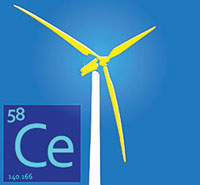By Jinfang Liu, Chief Operating Officer | Electron Energy Corp.
Permanent magnets are critical components for many applications including motors, generators, computers, instrumentation, automation, oil exploration, aerospace and defense systems.
Figure 1 shows the history of the permanent magnet development in the last 100 years. The maximum energy product, or (BH)max, has increased from a few MGOe to more than 50 MGOe. Commercially popular magnets nowadays include neodymium iron born (NdFeB), samarium cobalt (SmCo), Alnico, and ceramic magnets (also known as hard ferrite). NdFeB and SmCo are collectively known as Rare Earth magnets, which exhibit very high magnetic properties. Ceramic magnet is the least expensive option on the market.

If the total weight and overall size of the system are not a constraint at all, one may consider ceramic magnets because of their low cost. Ceramic magnets are still widely used today even though their maximum (BH)max is only about 4 MGOe. If the total weight and size are important, rare earth magnets are recommended because of their superior magnetic performance. Of course there are many factors to be considered when designing systems using permanent magnets. The following briefly describes a few important design considerations.
1. Operating Environment
Operating temperature has a significant impact on the selection of permanent magnets. Figure 2 shows the relationship between maximum operating temperature and maximum energy product, (BH)max, for permanent magnets. SmCo, Alnico and ceramic magnets can be used at elevated temperatures, while NdFeB can only be used at relatively lower temperatures. NdFeB magnets should be considered when you design a high performance system if the maximum operating temperature is below 150°C, while SmCo magnets would become a first choice if the maximum operating temperature is above 180°C.

SmCo, Alnico and ceramic magnets have very good corrosion resistance and, therefore, surface coatings are generally not necessary. Surface coating may be recommended for SmCo magnets when the maximum operating temperature is above 400°C.
NdFeB magnet does not have good corrosion resistance without surface protection. Corrosion generally starts from neodymium-rich grain boundary phase for unprotected NdFeB magnets, and intergranular decomposition could happen in an environment with high temperatures and high humidity. A simple passivation treatment will help protect NdFeB magnets in a temporary dry storage facility. For most of the applications, effective surface protection is necessary. Popular surface coating options include NiCuNi plating, Ni plating, zinc plating, aluminum ion vapor deposition and epoxy coating.
2. Reversible Temperature Coefficient of Residual Induction
Residual induction, Br, changes with temperature for permanent magnets. The reversible temperature coefficient (RTC) of Br is defined as:

where ∆Br is the change of residual induction and ∆T is the change of temperature.
The typical values of reversible temperature coefficient, a, for the major classes of permanent magnets are -0.2 percent/°C for ceramic magnets, -0.03 to -0.02 percent/°C for Alnico magnets, -0.11 percent/°C for NdFeB, -0.04 percent/°C for SmCo5 and -0.035 percent/°C for Sm2Co17-type magnets. The magnetic properties decrease with temperature relatively faster for NdFeB magnets. When designing a magnetic system, one can estimate the magnetic properties at the operating temperature based on the reversible temperature coefficient. Figure 3 shows the maximum energy product, (BH)max, versus temperature for NdFeB and SmCo magnets. Some popular NdFeB magnet grades, N46H, N42SH, N40UH and N35EH, are included Figure 3 to compare with SmCo2:17-33. The maximum energy product at room temperature for N46H, N42SH, N40UH, and N35EH are 46, 42, 40 and 35 MGOe, respectively, while SmCo2:17-33 has only 33 MGOe at room temperature. When the operating temperature is at 150°C, the (BH)max for SmCo2:17-33 magnet is actually comparable to most of the NdFeB grades and it is higher than that for N35EH. This phenomenon is directly related to the difference in reversible temperature coefficient of residual induction of these materials. One may want to choose SmCo magnets when designing a high performance magnetic system for high temperature applications, especially when the maximum operating temperature is above 180°C.

3. Permeance Coefficient
Permanent magnet always works at some points along the extrinsic (normal) demagnetization curve in a magnetic circuit, which normally include permanent magnets, soft magnetic materials such as iron to guide the flux, and air gaps. Unless it is in a closed magnetic circuit, every permanent magnet has its own self demagnetization field, which is determined by magnet geometry and surrounding environment. The permeance coefficient is related to the self-demagnetization effect, and defined mathematically as:
Pc = Bd/Hd
The permeance coefficient is also known as “load line”, “operating slope”, “working point” or “operating point”. Figure 4 shows typical demagnetization curves, load line and the working point of a permanent magnet.

In a magnetic system, permeance coefficient is a measurement related to how easily the magnetic flux “travels” from the North Pole to the South Pole of the magnet. It allows the magnetic design engineers to determine the working point of the magnet on the normal demagnetization curve based on the magnet geometry and its surrounding environment. As an example, for a standalone cylindrical magnet with magnetization direction along the length, the longer the cylinder is, the higher the permeance coefficient.
For Alnico magnets, the intrinsic coercivity is very low and can be easily demagnetized. This is the reason why Alnico magnets are always very long along the magnetization direction to ensure the working point is always above the knee of the normal demagnetization curve. For SmCo magnets, the normal demagnetization curve is a straight line up to 300°C, which provides a lot of design flexibility. Most of the high coercivity NdFeB magnets have straight normal demagnetization curves at room temperature, but not at elevated temperatures.

Figure 5 shows typical demagnetization curves at various temperatures for an NdFeB magnet N42H. Load lines #1 and #2 are two hypothetical load lines for two different designs. Please note, in a magnetic system, the load line does not always start from the origin because of the demagnetizing field from either neighboring electromagnetic coils or permanent magnets. It can be seen from Figure 5 that this N42H neodymium iron born magnet works fine up to 120°C in the magnet design with load line #1. Its working point is well above the knee at 120°C. But for the magnet circuit design with a load line of #2 as shown in Figure 5, N42H can only be used up to about 75°C because the working point is either too close to or below the knee of the normal demagnetization curve, if the temperature is above 100°C.
The recommended maximum operating temperature is 120°C for N42H from most product literatures with an assumption that the L/D ratio is above 0.7. Actual magnetic design is more complex; therefore, one should not blindly follow recommendations without detailed analysis. Please note that it is always wise to design a magnetic circuit with enough safety margins to allow room for error.
4. Coefficient of Thermal Expansion
The linear coefficient of thermal expansion is defined as the change in length of a material for a unit change in temperature, which can be written as:

where αL is the linear coefficient of thermal expansion, L is the length of the material, ∆L is the change in length, and ∆T is the change of temperature. Table 1 shows typical linear coefficient of thermal expansion, αL, within a temperature range of 20°C to 100°C for some conventional rare earth permanent magnets. It should be noted that the coefficient of thermal expansion is different along different directions for all rare earth magnets.
 Magnets are often assembled together with other metallic components in a system. For a motor or generator application, magnets may be assembled onto a shaft using adhesives. A containment band may also be needed to increase structural safety especially for high speed motors or generators. Materials with similar coefficient of thermal expansion in the same magnet assembly will help reduce the stress level, which is important for some high performance magnetic systems. The typical coefficient of thermal expansion is 24×10-6 /°C for aluminum, 17.2×10-6 /°C for 303 stainless steel, 13.3×10-6 /°C for Inconel and 8.9×10-6 /°C for titanium. The maximum stress level in the magnet assembly due to the difference in thermal expansion should be carefully evaluated in the design stage. Thermal cure adhesives are normally used in the magnet assembling process. The magnet assembly could fail even during manufacturing if other components used in the assembly have very different coefficient of thermal expansion.
Magnets are often assembled together with other metallic components in a system. For a motor or generator application, magnets may be assembled onto a shaft using adhesives. A containment band may also be needed to increase structural safety especially for high speed motors or generators. Materials with similar coefficient of thermal expansion in the same magnet assembly will help reduce the stress level, which is important for some high performance magnetic systems. The typical coefficient of thermal expansion is 24×10-6 /°C for aluminum, 17.2×10-6 /°C for 303 stainless steel, 13.3×10-6 /°C for Inconel and 8.9×10-6 /°C for titanium. The maximum stress level in the magnet assembly due to the difference in thermal expansion should be carefully evaluated in the design stage. Thermal cure adhesives are normally used in the magnet assembling process. The magnet assembly could fail even during manufacturing if other components used in the assembly have very different coefficient of thermal expansion.
Summary
Many factors need to be taken into consideration when designing a magnetic system including magnetic performance, weight and size constraints, maximum designed operating temperature, service environment such as temperature and humidity, corrosion resistance requirements and surface protection options, cumulative mechanical tolerance due to surface coating, reversible temperature coefficient of residual induction, permeance coefficient, and coefficient of thermal expansion. It is advisable to have close collaborations between mechanical/electrical design engineers and magnetics engineers in the design and prototype stage.
 About the Author
About the Author
Jinfang Liu received his Ph.D. in physics in 1990 from the Institute of Physics, Chinese Academy of Sciences. He did post-doctoral research work at Central Iron and Steel Research Institute (China), University of Sheffield (UK), and University of Delaware (USA). Dr. Liu has over 25 years of experience in the field of permanent magnets and magnetic systems. He held various positions at industrial corporations including Arnold Swift Levick Magnets Limited (UK) and NEOREM Magnets Limited (Finland) before joining Electron Energy Corp. (USA) in 1998. He currently serves as the chief operating officer at Electron Energy Corporation. He is a co-author of more than 200 papers on permanent magnets and magnetic systems and co-inventor of 12 issued US patents.
www.electronenergy.com



